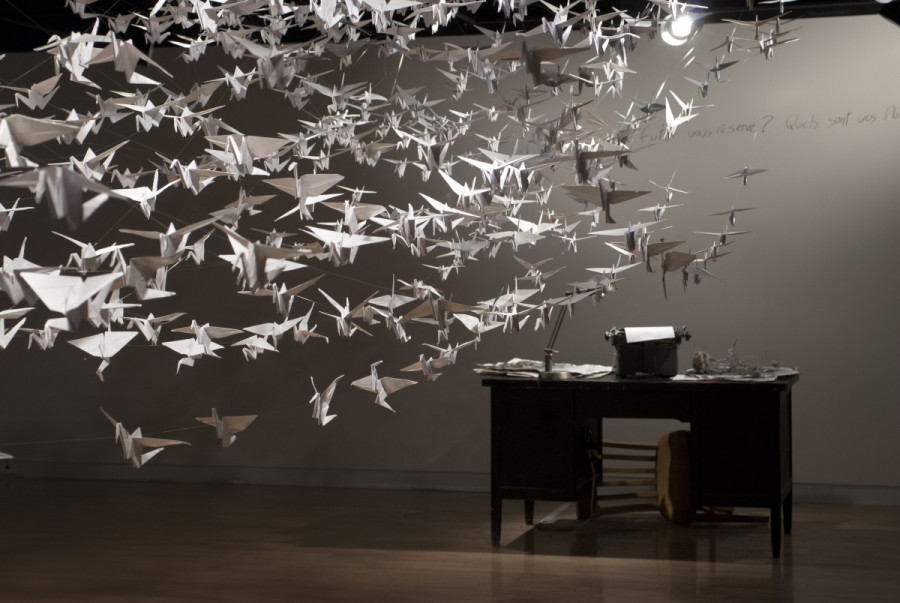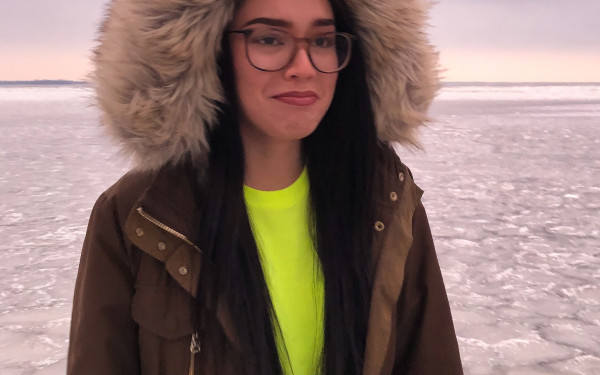Into The Folds Of The Unknown
Yanick Sasseville Explores Expectations and Reality Through Origami and Photography
You’re travelling from point A to B with an idea of where you’re headed. You have expectations to be fulfilled when you get there, but the truth is you can’t predict the future.
Yanick Sasseville’s Exil: Vérité trompeuse is a three-dimensional art exhibition displaying thousands of paper origami birds that morph out of a typewriter and fly from one side of the room to the other. The birds fill the space around the ceiling and head towards a window, which stands in front of a painted landscape.
The idea of expectation versus false reality is the main idea behind Sasseville’s artwork. “When you’re in the process of going somewhere, you’re in the unknown—you’re not where you were, and you’re not in your final destination, but until you get there, you won’t know if it will be what you expected,” he said.
The thought-provoking art installment has been on display now for nearly two months at Montreal’s TOHU. The free exhibit allows audiences to experience the process of “exile” from their own point of view.
Footprints lead to a desk that sits in the foreground and a typewriter on it has a page that reads, “Qu’est-ce que le future me réserve, et suis-je prêt?” The phrase was translated from Edward Abbey’s 1975 book Monkey Ranch Gang.
Sasseville’s idea also stemmed from René Magritte’s 1929 oil painting The Treachery of Images, which depicts a pipe under which the words “Ceci n’est pas une pipe” (“This is not a pipe”) are written.
“Whenever you draw or paint an image of something, it’s not the object,” Sasseville said. “So I played with that kind of thought. It’s the unknown, you have to guess.”
The work has evolved over the course of five years. The exhibit was first shown in Sept-Îles and then moved on to galleries in Baie-Comeau and Trois-Rivières before coming to Montreal. Sasseville altered his installation depending on the room he had available. Throughout the process, the message he was trying to get across changed as well. “When I started, it was a bit too simplistic. It eventually evolved into something more personal,” he said.
The large space at TOHU allowed him to include two big paintings that he had made for previous works, measuring nine by 20 feet each. “As I work on many things at the same time, I will always get inspired by what I do and bring ideas into other projects, and take one part of a project and transform it into something else. In the studio, I can do pretty much anything with my work,” he said.
The paper cranes he made were all recycled paper from screenplays that Sasseville’s film-director friends had finished using. “It made sense, because in every bird there’s something written, and it kind of goes with the typewriter,” he said.
To Sasseville, the underlying message is you can only believe what you can find. Having friends that came to Montreal from France and Belgium allowed him to see the problems they encountered when they arrived firsthand. As similar as Montreal may be to those European countries, “nothing was exactly as they thought it would be,” he said.
“When you watch the TV and see what is happening in another country, is that really what is happening? Or only what is chosen by that network? There could be a whole set of facts that may be left out, or shown on another station,” he said.
Sasseville believes in open interpretations of Exil: Vérité trompeuse. “Even if I explain my way of seeing it, […] my guidelines are not the same as the person standing next to me. Audiences should get what they want from the artwork,” he said.
If there are questions, however, he’ll be happy to explain his ideas as well.
His favourite part of being an artist is solving problems. “It’s the first piece of any project. Before or during the first draft, I have to question myself […] and find loopholes, or something that doesn’t work. Then I have to come up with an answer,” he said.
After that, the process is just mechanics, and he must piece the project together. “It’s [also] fun, but it took me a while to realize that I love to solve problems.”
At the moment, his biggest challenge is to find a way to connect with audiences. “I think I’m really sensitive. I have my eyes open, I see what’s going on around me, and I focus on that,” he said.
Sasseville doesn’t see himself as an artist who produces work with a consistent message or connected themes.
“I’d be full of shit to tell you that that’s the kind of artist I am,” he said.
“Art is what I do, but at the same time I’m really insecure. I can’t just say, ‘OK, I do this.’ It’s always a tug of war between following my gut feeling and doing the right thing. […] It’s part of who I am, and that’s the reason why I create the way I create.”


_600_832_s.png)

_600_375_90_s_c1.jpg)
2_600_375_90_s_c1.jpg)
_600_375_90_s_c1.jpg)
